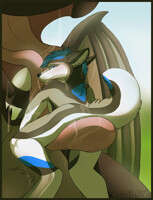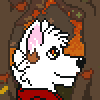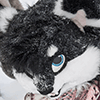
A full colour commission for Kiba featuring himself with a pair of rattan sticks.
I was asked to base the pose on this photo.
Category Artwork (Digital) / General Furry Art
Species Wolf
Size 772 x 1000px
File Size 302.2 kB
I didn't notice that much bending when I used rattan sticks in eskrima... was probably too busy thinking about beating up the bag (during stamina training), not clobbering the partner's hand (during drill stuffs), or making sure I /hit/ the opponent (during contest).
Oh... but that doesn't mean they don't hurt when you get hit...
Oh... but that doesn't mean they don't hurt when you get hit...
Arnis seems to be an umbrella term that covers a lot of the Philippine martial arts, which uses various other things than just the rattan: http://en.wikipedia.org/wiki/Eskrima
Modern arnis might be the thing you got taught in school? Seems to be self defense type stuff: http://en.wikipedia.org/wiki/Modern_Arnis
So many things to research *wades through wikipedia*
Modern arnis might be the thing you got taught in school? Seems to be self defense type stuff: http://en.wikipedia.org/wiki/Modern_Arnis
So many things to research *wades through wikipedia*
Actually... Arnis℥Kali Arnis℥Doce Paris℥Eskrima is very much _NOT_ "more defensive". The deal with using sticks is, when the Spanish came, they outlawed natives from using blades, or practicing martial art (so... you know... they couldn't revolt...). The Pilipinos taught and practiced eskrima using rattan sticks, claiming that the affair was a ceremonial dance... which is why watching an eskrimadore (eskrima master) looks kinda like they're dancing.
Also... It is _VERY_ possible to attack someone using rattan sticks... they hurt (a lot), and there are nasty moves that could be fatal (I'm thinking of the punyo strike (the punyo is the little bit of stick left near where you hold)) and are banned in competition. They aren't called "death matches" for a reason... but those typically involve knives at some point.
Oh... in case you didn't learn this in PE... the techniques you learn with the sticks translate almost perfectly to using knives and other blades... though a broken stick probably isn't pointy enough for use as a stabbing weapon... rattan is kinda flimsy once it is no longer collected in a club...
I'm glad you learned something useful in PE, though! The whole "defensive only" thing was probably to keep you guys from beating each other up, or being stupid and attacking someone on the street. My karate instructor referred to it as "might for right".
Also... It is _VERY_ possible to attack someone using rattan sticks... they hurt (a lot), and there are nasty moves that could be fatal (I'm thinking of the punyo strike (the punyo is the little bit of stick left near where you hold)) and are banned in competition. They aren't called "death matches" for a reason... but those typically involve knives at some point.
Oh... in case you didn't learn this in PE... the techniques you learn with the sticks translate almost perfectly to using knives and other blades... though a broken stick probably isn't pointy enough for use as a stabbing weapon... rattan is kinda flimsy once it is no longer collected in a club...
I'm glad you learned something useful in PE, though! The whole "defensive only" thing was probably to keep you guys from beating each other up, or being stupid and attacking someone on the street. My karate instructor referred to it as "might for right".
i really like this pic i want a pic like this some day i practice
Siete Pares Escrima with my dad and bro i have a video up
its just a short video im the one with the hat lol
here it is http://www.youtube.com/watch?v=JsiN_SIB-oE
Siete Pares Escrima with my dad and bro i have a video up
its just a short video im the one with the hat lol
here it is http://www.youtube.com/watch?v=JsiN_SIB-oE
I see a little misinformation going on and although years later,I believe it's better to know something later than curse ignorance now.
1)Arnis,eskrima,and kali are universal terms in the Philippines for FMA and can be used when looking for a school but with today's internet you can find out which variation is used for a particular school.
2)FMA is offensive-counter-offensive and not defensive.
3)The stories of the ban on blades is more of a romanticized story similar to the Okinawan karate belt system story. History and common sense have proven these to be both wrong.
4)The sticks were created mainly to reduce the amount of injuries and deaths that most often resulted in training with a live blade similar to the Japanese use of the bokken.
5)Punyo was designed to strike soft targets such as the eyes,nose,and temples. It's only banned in tournaments as you don't want to seriously injure your opponent(s).
6)Eskrimadore refers to a male practitioner of eskrima. Different systems use different terminology for masters but most common is Master,Grand Master,Guro,Tuhon,and Grand Tuhon.
7)Rattan is not a hardwood. It's a palm that's hardened with fire and in some rare cases a combination of fire and oils. Kamagong or black ivory is a hardwood as the tree is closely related to ironwood trees. Like any type of wooden object, your sticks should be firm. If they're flexible discard and get new ones.
8)Death matches were an occurrence during the 50's and 60's between different schools to see who was better. They've since been banned.
1)Arnis,eskrima,and kali are universal terms in the Philippines for FMA and can be used when looking for a school but with today's internet you can find out which variation is used for a particular school.
2)FMA is offensive-counter-offensive and not defensive.
3)The stories of the ban on blades is more of a romanticized story similar to the Okinawan karate belt system story. History and common sense have proven these to be both wrong.
4)The sticks were created mainly to reduce the amount of injuries and deaths that most often resulted in training with a live blade similar to the Japanese use of the bokken.
5)Punyo was designed to strike soft targets such as the eyes,nose,and temples. It's only banned in tournaments as you don't want to seriously injure your opponent(s).
6)Eskrimadore refers to a male practitioner of eskrima. Different systems use different terminology for masters but most common is Master,Grand Master,Guro,Tuhon,and Grand Tuhon.
7)Rattan is not a hardwood. It's a palm that's hardened with fire and in some rare cases a combination of fire and oils. Kamagong or black ivory is a hardwood as the tree is closely related to ironwood trees. Like any type of wooden object, your sticks should be firm. If they're flexible discard and get new ones.
8)Death matches were an occurrence during the 50's and 60's between different schools to see who was better. They've since been banned.
Almost forgot 3 other things.
1)The photo is of Grand Master Jonathan "June" Makiling Abaya who's the founder of Jendo.
2)The shoes being worn are actually a modern take on the Shaolin Luohan sandals that monks made from straw centuries ago. Although monks wear Feiyue shoes for training they also wear these for training(save for kicking as it would wear down the shows quickly) in the higher parts of the mountains,long distance travel,or to be quicker on a short walk. The sides are open to help keep the feet cool as Dengfeng gets around 34C(93F) and hotter in the summer or closed tho keep the feet warm in the winter.
3)Although not present on this pic but present on some of the others is a black sash. The sash is not indicative of rank. It's how the monks kept their pants up during training. Chinese martial arts believe in achievement through time and effort or as you know it: Kung-fu,Gung-fu,Gong-fu.
1)The photo is of Grand Master Jonathan "June" Makiling Abaya who's the founder of Jendo.
2)The shoes being worn are actually a modern take on the Shaolin Luohan sandals that monks made from straw centuries ago. Although monks wear Feiyue shoes for training they also wear these for training(save for kicking as it would wear down the shows quickly) in the higher parts of the mountains,long distance travel,or to be quicker on a short walk. The sides are open to help keep the feet cool as Dengfeng gets around 34C(93F) and hotter in the summer or closed tho keep the feet warm in the winter.
3)Although not present on this pic but present on some of the others is a black sash. The sash is not indicative of rank. It's how the monks kept their pants up during training. Chinese martial arts believe in achievement through time and effort or as you know it: Kung-fu,Gung-fu,Gong-fu.
And because I didn't catch this earlier: sinawali isn't being used here. Instead of going through a boring lecture people hate, here's a video of kuya Doug Marcaida to show you: https://www.youtube.com/watch?v=OhHIJ8XLrh4

 FA+
FA+




![[Clean] The Highlands](http://t.furaffinity.net/6128036@200-1310786732.jpg)









































Comments